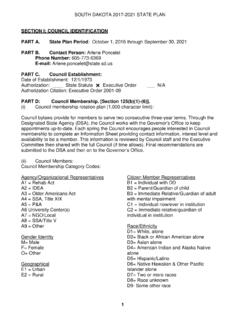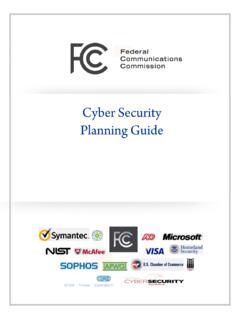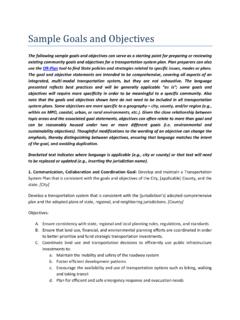Transcription of HIPAA Security Policies and Procedures Manual
1 Page 1 of 72 South Dakota Department of Human Services HIPAA Security Policies and Procedures Manual August 2019 Policy Title: HIPAA Security Policies and Procedures Policy Number: DHS- Version: Approved By: Effective Date: August 1, 2019 Reviewed Date: Page 2 of 72 Table of Contents Risk Management Policy .. 3 Contingency Plan Policy .. 8 Data Management 13 Auditing Policy .. 16 HIPAA Security Oversight Policy .. 21 Incidents Policy: Security Incident Response, Breach Notifications, and Sanctions .. 25 System Access Policy .. 33 Business Associate Policy .. 40 Facility Access Policy .. 46 Facility Maintenance Policy.
2 50 PHI and ePHI Disposal Policy .. 52 Technical Access Control Policy: Transmission Security , Encryption, and Integrity .. 57 Group Health Plan Policy .. 62 HIPAA Security Policies & Procedures : Key Definitions .. 63 Page 3 of 72 Risk Management Policy Purpose To establish the Security risk management process of South Dakota Department of Human Services (DHS), as required by the HIPAA Security Regulations, by implementing Policies and Procedures to prevent, detect, contain, and correct Security violations. To accurately assess, and implement Security measures to reduce risks and vulnerabilities to the confidentiality, integrity, and availability of electronic protected health information (ePHI) held by DHS. Responsible for Implementation: Security Officer, Risk Management Team members Risk Management Team members: Security Officer, Privacy Officer, representatives of the Bureau of Information & Telecommunications (BIT) of the State of South Dakota Policy 1.
3 This Policy shall work in accordance with the Risk Management policy of the Information Technology (IT) Security Policy developed by BIT. 2. DHS periodically conducts, reviews, and updates an assessment of the potential risks to the confidentiality, integrity, and availability of DHS s ePHI, and implements Security measures to reduce identified risks to a reasonable and appropriate level. 3. Risk analysis and risk management are recognized as important parts of DHS s Security compliance program, in accordance with the requirements in the HIPAA Security Regulations. A. To the extent possible, risk assessments are done before the purchase or integration of new technologies, prior to changes made to physical safeguards, and while integrating technology and making physical Security changes. B. DHS performs periodic technical and non-technical assessments of the HIPAA Security requirements in response to environmental or operational changes affecting the Security of ePHI.
4 4. DHS implements Security measures sufficient to reduce risks and vulnerabilities to a reasonable and appropriate level to: A. Ensure the confidentiality, integrity, and availability of all ePHI that DHS creates, receives, maintains, or transmits. B. Protect against any reasonably anticipated Threats or hazards to the Security or integrity of ePHI. Page 4 of 72 C. Protect against any reasonably anticipated uses or disclosures of ePHI that are not permitted or required. D. Ensure Workforce compliance with Security requirements. 5. All Workforce members are expected to fully cooperate with all persons charged with doing risk management work. 6. All risk management efforts, including decisions made on what controls to put in place as well as those to not put into place, are documented and the documentation is maintained for six years.
5 Procedures 1. The Security Officer and the Risk Management Team oversee the Security risk analysis and risk management process. 2. Risk Assessment A risk assessment is performed to determine the potential risks and vulnerabilities to the confidentiality, integrity, and availability of ePHI held by DHS. The following steps from the risk assessment methodology found in NIST Special Publication 800-30 are used to conduct risk assessments. Some of the steps may also be used when purchasing, upgrading, or moving ePHI systems and as needed to assist in the risk management efforts of DHS. Step 1. System Characterization: Define the scope of the effort, including the operating environment and boundaries of the Information System. Identify where ePHI is created, received, maintained, processed, or transmitted. Consider remote work force and telecommuters, as well as removable media and portable computing devices.
6 Step 2. Threat Identification: Identify and document potential Threats, which are anything that can have a negative impact on ePHI. A Threat, which may be intentional or unintentional, exists when there is the potential for a Threat Source to successfully exploit a Vulnerability. Threat Sources can be natural, human, or environmental. Step 3. Vulnerability Identification: Develop a list of technical and non-technical system vulnerabilities (flaws or weaknesses) that could be exploited by potential Threat Sources. Vulnerabilities may include incomplete information Security Policies , insufficient safeguards to protect facilities and equipment housing ePHI, and lack of Workforce Security training. Step 4. Control Analysis: Document and assess the effectiveness of technical and non-technical controls that have been or will be implemented by DHS to minimize or eliminate the likelihood of a Threat Source exploiting a Vulnerability.
7 Page 5 of 72 Step 5. Likelihood Determination: Determine the probability that a Vulnerability may be exploited by a Threat Source given the existing or planned Security controls. Step 6. Impact Analysis: Determine the level of adverse impact that would result from a Threat Source successfully exploiting a Vulnerability. Factors to consider include the importance to the mission of DHS; sensitivity and criticality of the ePHI; associated costs; and loss of confidentiality, integrity, and availability of systems and data. Step 7. Risk Determination: Determine risk level by multiplying the ratings from the likelihood determination and impact analysis. This represents the level of risk to which an IT system may be exposed if a Vulnerability were to be successfully exploited by a Threat Source.
8 Step 8. Control Recommendations: Identify controls that could mitigate the identified risks, to reduce risk to the IT system and its ePHI to an acceptable level. Factors to consider when developing controls may include system compatibility, organizational policy, operational impact, safety/reliability, and cost effectiveness ( cost-benefit analysis). Step 9. Results Documentation: Document results of the risk assessment (Threat Sources and Vulnerabilities identified, risks assessed, Security controls recommended, etc.) in a report and provide to senior leadership to assist with decisions on policy, procedure, budget, and system operational and management changes. 3. Risk Mitigation Risk mitigation involves evaluating, selecting, and implementing the appropriate risk-reducing controls recommended from the risk assessment process to ensure the confidentiality, integrity and availability of ePHI.
9 The following steps may be utilized to make determinations of the appropriate controls to put into place. Some of the steps may also be utilized when purchasing, upgrading, or moving ePHI systems and as needed to assist in the risk management efforts of DHS. Step 1. Risk Analysis Results: The results from Step 7 of the Risk Assessment, ranked from high to low, form the basis of the risk management efforts of DHS. Step 2. Evaluation of Control Options: Review recommended control(s) and alternative solutions for reasonableness and appropriateness. The feasibility and effectiveness of the recommended controls should be evaluated. Select potential control options for each identified risk and document reasons for selection. Step 3. Cost-Benefit Analysis: Determine the extent to which a potential control is cost-effective. Compare the benefit (amount of risk reduction) of applying a control with its cost of application/ implementation.
10 Page 6 of 72 Step 4. Selection of Control(s): Based on the cost-benefit analysis, select the most reasonable, appropriate, and cost-effective controls to reduce identified risks to the information system and to the confidentiality, integrity, and availability of ePHI. Controls selected may consist of a mix of administrative, physical, and/or technical safeguards. Step 5. Responsibility: Identify the Workforce member(s) or team with the skills necessary to implement each of the selected controls and assign their responsibilities. Identify the equipment, training and other resources needed for the successful implementation of controls. Step 6. Implementation: The responsible Workforce member(s) or team properly implements the selected Security control(s).









